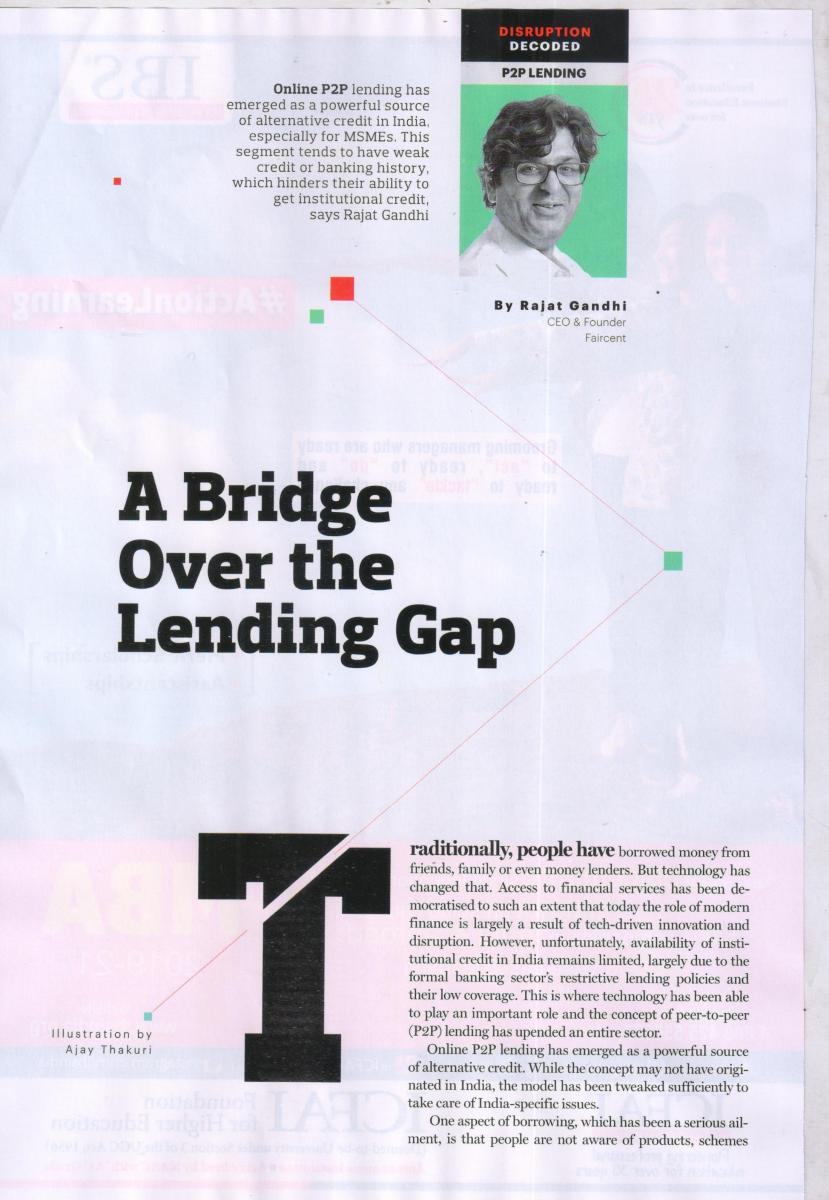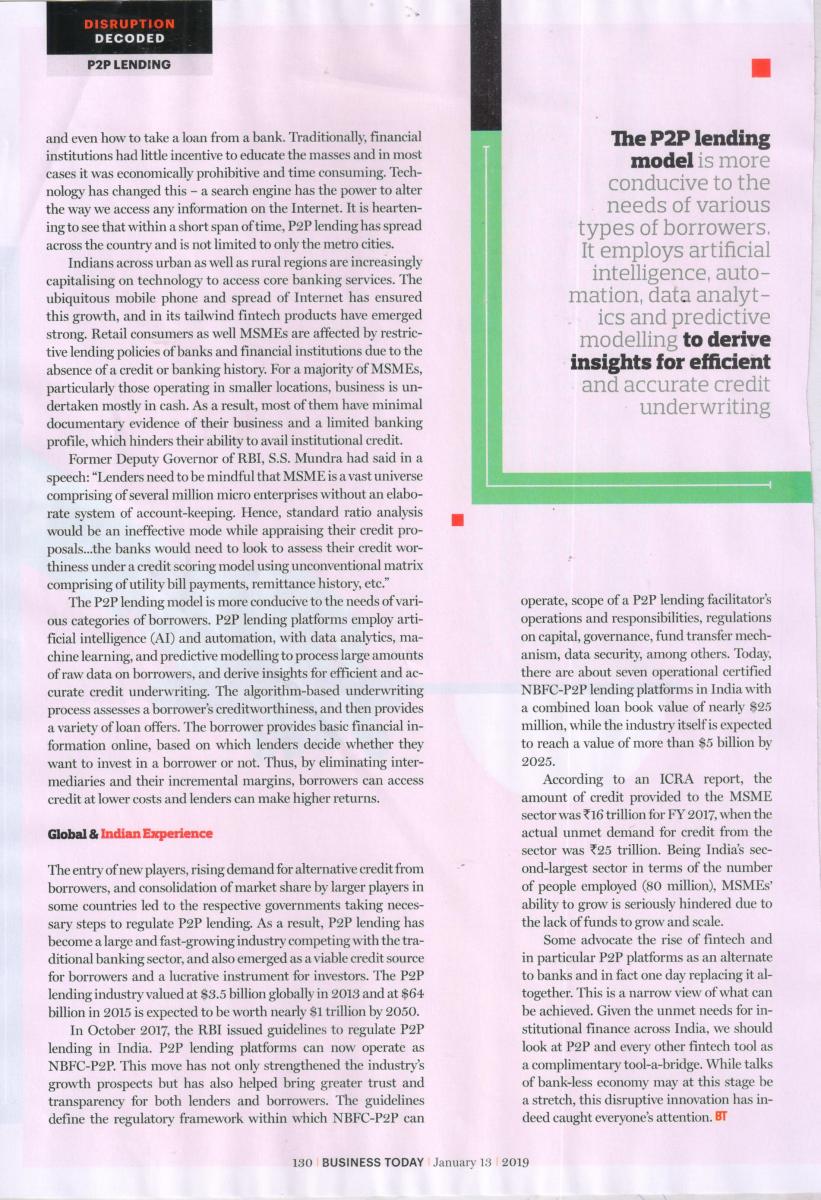Bridging the lending gap: Creating avenues for socio-economic growth for the masses by simplifying access to credit
Across the globe, technology and digitisation are rapidly changing the face of banking and financial services. More importantly, though, technology has democratised access to specific financial services on which banks and financial institutions earlier had a stronghold.
Organised lending and borrowing can be traced back to 700 years ago with limited scope and activity. However, over centuries banking and financial services have changed and today, the role of modern finance is largely a result of tech-driven innovation and disruption. Consider lending, which is one of the most fundamental banking services, and access to credit is an essential element of socioeconomic group for individuals and households. Unfortunately, availability of institutional credit in India still remains limited to an extremely small segment of the population.
This is largely due to the formal banking sector’s restrictive policies when it comes to lending as well as due to their low coverage in rural and more remote parts of the country. This low level of financial inclusion within the country is a critical factor that has restricted a majority of the population from being able to avail credit, either for personal consumption or to finance their entrepreneurial endeavours.
This is where technology has been able to play a very important role and the concept of peer-to-peer (P2P) lending has upended an entire sector. Borrowing from the age-old concept of social or community-based lending and integrating it with a modern, technology-driven marketplace lending model, online P2P lending has emerged as a powerful source of alternative credit in today’s age.
P2P lending: Bridging the information gap
P2P lending as a concept may not have originated in India, but the model has been tweaked sufficiently to take care of India-specific issues. Despite the fundamental differences between India’s rural and urban populace, one thing that remains common across the majority is the demand for credit as well as the lack of access to it.
One aspect of borrowing, which has been a serious ailment, is the ignorance about products, schemes and even the process of raising money from a bank. Traditionally, financial institutions had very little incentive to educate the masses and in most cases it was economically prohibitive and a time consuming exercise. We have all seen the clout of technology, where a search engine has the power to alter the way we access any information on the Internet. Similarly, technology alone has the power to go deep and address issues like lack of knowledge. It is heartening to see that within a short span of time P2P lending has spread across the country and is not limited to the metro cities of the country.
P2P lending: Taking banking to the unbanked
Indians across both urban as well as rural regions are increasingly becoming tech-savvy and have been capitalising on technology to access core banking services such as payments, money transfers, etc. over the past couple of years. The ubiquitous mobile and spread of the Internet to the far corners of the country has ensured this growth and that is in fact the beauty of all fintech products. As technology grows and spreads, no one can be stopped from accessing financial products that uplift and support a borrower.
Both consumers as well as micro, small, and medium-sized enterprises (MSMEs) are affected by restrictive lending policies of banks and financial institutions due to the absence of a credit or banking history or CIBIL scores. For a majority of MSMEs, particularly those operating in tier II, III, and IV regions, business activities are undertaken through cash. As a result, most of these enterprises have minimal documentary evidence of their business activities and a limited banking profile, which hinders their ability to avail institutional credit.
Former Deputy Governor of the RBI, Mr. SS Mundra in a speech has said, “Lenders need to be mindful that MSME is a vast universe comprising of several million micro enterprises without an elaborate system of account-keeping. Hence, standard ratio analysis would be an ineffective mode while apprising their credit proposals. In such cases, the banks would need to look to assess their credit worthiness under a credit scoring model using unconventional matrix comprising of utility bill payments, remittance history etc.”
The peer-to-peer lending model is more conducive to the needs of various categories of borrowers, which enables them to interact directly with lenders through an open and transparent online marketplace, without the involvement of banks or financial intermediaries.
P2P lending platforms employ AI and automation, with data analytics, machine learning, and predictive modelling to process large amounts of raw data on borrowers and derive insights for efficient and accurate credit underwriting. The algorithm-based underwriting process assesses a borrower’s creditworthiness, and then provides the borrower with a variety of loan offers which match with their specific requirements. This is basis simple personal and financial information provided by the borrower online at the time of registration. This data is also provided to the lenders which they use to decide whether they want to invest in a borrower or not. Thus, by eliminating intermediaries and their incremental margins, borrowers can access credit at lower costs and lenders can make higher returns on their surplus funds.
Global & Indian experience
P2P lending has grown exponentially across some of the world’s biggest economies such as the USA, the UK, Canada, France, Germany, and China. The entry of new players, rising demand for alternative credit from borrowers, and consolidation of market share by larger players in some of these countries led to the respective governments taking necessary steps to regulate P2P lending. As a result, not only has P2P lending becoming a large and fast-growing industry competing with the traditional banking sector, but has also emerged as a viable credit source for borrowers and a lucrative investment instrument for investors. The P2P lending industry valued at $3.5 billion globally in 2013 and at $64 billion in 2015 is expected to be worth nearly $1 trillion by 2050.
In October 2017, the RBI issued guidelines to regulate the P2P lending industry in India. P2P lending platforms can now operate as NBFC-P2P. This move has not only strengthened the industry’s growth prospects but has also helped bring greater trust and transparency for both P2P lenders and borrowers. The guidelines define the regulatory framework within which NBFC-P2P can operate, scope of a P2P lending facilitator’s operations and responsibilities, regulations on capital, governance, fund transfer mechanism, data security among others.
Looking at the future
Given the surge in demand for credit across all verticals and the inability of the country’s traditional banking sector to meet them, it is no surprise that P2P lending is fast emerging as a saviour to underserved and credit-starved segments. Today, there are approx 7 operational certified NBFC-P2P lending platforms in India with a combined loan book value of nearly $25 million, while the industry itself is expected to reach a value of more than USD 5 billion by 2025.
According to a report by ICRA, the amount of credit provided to the MSME sector stood at INR 16 trillion for FY 2017. Compare this to the actual unmet demand for credit from the sector – a massive INR 25 trillion. Being India’s second-largest sector in terms of the number of people employed (80 million), its ability to grow is seriously hindered due to the lack of funds to grow and scale.
Some advocate the rise of fintech and in particular the P2P platforms as an alternate to banks and in fact one day replacing it all together. To my mind, this is a narrow view of what can be achieved. Given the unmet needs for institutional finance across India, we should look at P2P and every other fintech tool as a complimentary tool-a-bridge. Across the world standard setting bodies like the Financial Stability Board, the Basle Committee on Banking Supervision and others have formed special teams to understand and examine the disruptions taking place. While talks of bank-less economy may at this stage be a stretch, there is no denying the fact that this disruptive innovation has indeed caught everyone’s attention.
The article appeared as part of Business Today Anniversary Issue January 2019


Related Articles
-
P2P platforms facilitating a structed Lending ecosystem
Jun 24, 2022
-
P2P Lending in India: A revolution in the making
Mar 28, 2018
-
Madam FM, P2P lending Can Help MSMEs
Feb 11, 2020
